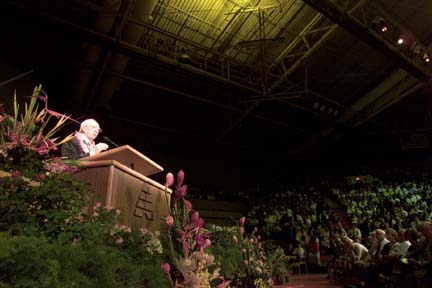

|
View from the Pew Mary Adamski |
CINDY ELLEN RUSSELL / CRUSSELL@STARBULLETIN.COM
Gordon Hinckley, president of the Church of Jesus Christ of Latter-day Saints, discussed the problem of "ice" Sunday during a speech at Brigham Young University-Hawaii.
Righteous
maturityTwo gatherings stress the
importance of youngsters’
sense of spiritual worthA man revered as a prophet by 11 million church members came here last week to celebrate the anniversary of an enormously successful financial enterprise and to launch a multimillion-dollar project.
But Gordon Hinckley, president of the Church of Jesus Christ of Latter-day Saints, turned from the Polynesian Cultural Center festivities to focus a Sunday service on how enormously important it is for young people to respect their spiritual worth.
"You cannot lower yourself to be tempted by these things that are so common in the world," Hinckley said in a pastoral talk that reflected his concern about the scourge of "ice," or methamphetamine, abuse here. He spoke to a crowd of 7,000 people at Brigham Young University Hawaii in a program broadcast to the state's Mormon congregations.
"When we sing 'I am a child of God,' we know it is true," the 93-year-old leader said. "There is something of divinity in me and all of us." He reminded young men that they are considered to belong to the biblical priesthood. "How would you think of taking ice? We ought to stand taller and stronger than we do."
He told the adults that church founder Joseph Smith said: "You don't have to beat your children. Speak with them, explain to them what is expected of them."
Hinckley's message was addressed to his own flock, but it echoes the effort of leaders from every imaginable spiritual path to teach that drugs and alcohol, promiscuity and possessions aren't true measures of self-esteem.
CINDY ELLEN RUSSELL / CRUSSELL@STARBULLETIN.COM
The Polynesian Cultural Center Choir sang "We Ever Pray for Thee" at BYUH on Sunday as part of the center's 40th-anniversary celebration.
A young woman who has learned that lesson well reversed roles and was teacher to a gathering of her elders Tuesday night. The monthly meeting of All Believers Network, an Oahu interfaith forum that seeks to understand each other's faith traditions, heard Grace Horne describe her American Indian spiritual heritage. Although poles apart from the Sunday gathering at Laie, it brought a similar message.
"It's not just a religion. I can't separate it. It is a way of life," Horne told her audience of 20 people who identified themselves as being from eight faith traditions.
"You choose who you want to be, to take a positive or negative path. There are consequences from taking a negative path," said Horne, 20, whose parents are from Lakota and Dakota tribes based in South Dakota. She recently moved to Hawaii from Minnesota to accompany her sister to school here. Her father, Arvol Looking Horse, is a tribal spiritual leader, chosen to be 19th-generation keeper of the Lakota sacred pipe. He is a founder of World Peace and Prayer Day, a gathering of aboriginal spiritual leaders held in a different country each year.
She said her people's beliefs are not taught in the context of rules such as the 10 Commandments, but through stories that carry messages and models. People are taught to consider their responsibilities to the next seven generations to come.
"We have boundaries when we grow up." About people who abandoned their tribal values, tempted by greed, alcohol and other debris of the modern world, "we say they lost their boundaries."
She described the coming-of-age rite in which a teenager, prepared by elders, goes on a solitary retreat into the wilderness. It is four days of prayer, fasting from food and drink, without sleep. "It is to find out who you are," said Horne. "The spirits give you a vision. You earn your name by doing something courageous." It is traditional to experience the "vision quest" at age 12. Horne said she didn't complete it until she was 17, and she continues to fast and pray before participating in tribal dance events.
The idea of teens on a vision quest intrigued Horne's audience of people one or two generations older than she.
Many religions set a rite of passage intended to help the transition, said one man, comparing the American Indian ritual to a Jewish bar mitzvah or Christian confirmation.
"Modern society has done just the opposite," said another. "'Teenager' has become a subspecies, where you let them alone with their crazy music and friends and hope they come back to human at the end of it."
"Don't blame teenagers," said a third listener. "If we are responsible for seven generations ahead, someone let go a few generations back."
See the Columnists section for some past articles.
Religion Calendar
Mary Adamski covers religion for the Star-Bulletin.
Email her at madamski@starbulletin.com.

